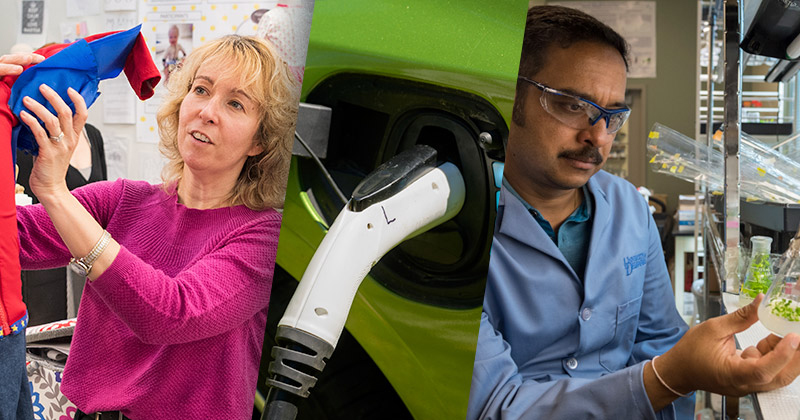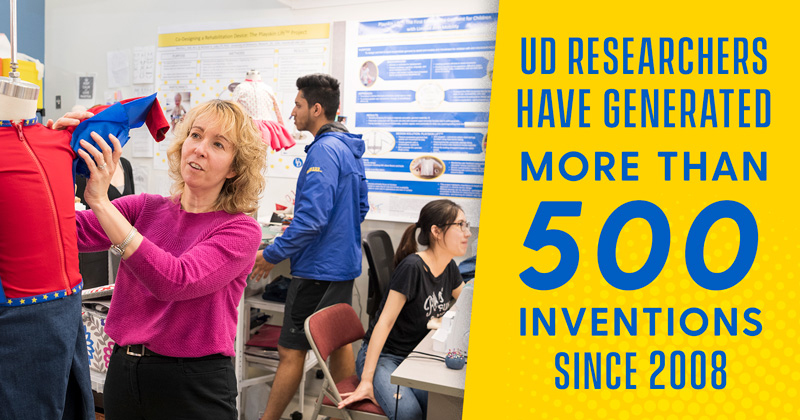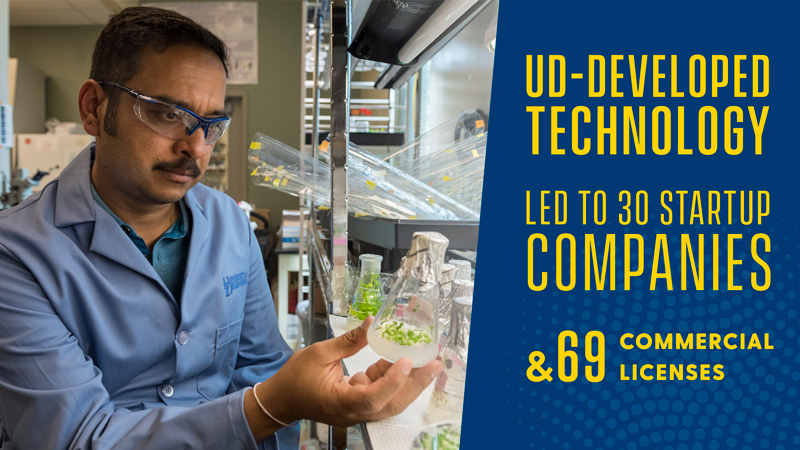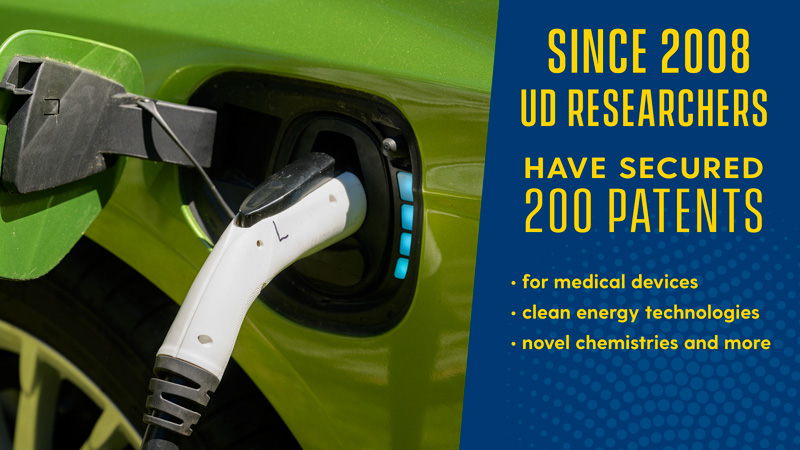


Tech transfer 101
Photo illustrations by Jeffrey C. Chase September 03, 2019
UD professionals shed light on commercializing UD-developed innovations
University of Delaware researchers have generated more than 500 inventions and secured 200 patents since 2008. Thirty startup companies have resulted from the licensing of UD technology, as well as 69 additional commercial licenses. One world-changing discovery to emerge from UD is literally right at your fingertips. UD researchers invented the multi-touch technology, a functionality that enables modern touchscreen capabilities found in smartphones, tablets and other electronic devices worldwide.
These achievements are part of what the Association of University Technology Managers (AUTM) say is a nearly $600 billion contribution to the U.S. gross domestic product by American academic institutions over a recent 20-year period. Some 4.3 million jobs were created or supported during that time by those inventions.
In the fall of 2018, UD recognized over 225 innovators on campus, including the inventor of the vehicle-to-grid technology (V2G) that lets electric cars store energy and then feed it back to the power grid, further enabling an economic model by which the electric vehicle might thrive and provide energy balancing services as more wind and solar energy comes online.
Managing and maintaining UD’s intellectual property (IP) portfolio, while simultaneously steering, mentoring and guiding entrepreneurial faculty with promising ideas in starting businesses and commercializing technology, is a complex job. But it is worth the effort, according to David Weir, director of UD’s Office of Economic Innovation and Partnerships (OEIP), where UD’s Technology Transfer unit is housed.
“OEIP's Technology Transfer unit, with its success in supporting faculty start-ups, licensing UD inventions and developing sustainable business partnerships within the private sector, has developed into a signature asset,” Weir said. “It is a resource that is critical to a stimulating and productive UD culture of innovation, entrepreneurship and market impact.”
In the following Q&A, UD technology transfer experts Brad Yops, director of technology transfer, and Joy Goswami, assistant director of technology transfer, break down what this activity means at UD. In September Yops will join UD’s Office of General Counsel where he will, among other things, continue to provide legal support to OEIP and its technology transfer function.
Q: What is technology transfer?
Goswami: In its simplest form, technology transfer involves transferring the right to commercialize innovations that result from scientific research at UD to corporate entities that can make them into marketable products that can be made available to the public, and ultimately, improve people’s lives. It starts with researchers coming to our office with an innovation and sharing why it may be commercially significant. Our team works with the inventor(s) to evaluate the innovation primarily based upon patentability and commercial viability. We then safeguard the interests of UD and the inventor by filing for IP protection, in the form of patents, trademarks or copyrights, depending on the innovation, and strategizing a commercialization path to increase the likelihood that the innovation reaches the marketplace.
Yops: Nationally, academic technology transfer took off in 1980 with the Bayh-Dole Act, a landmark law that permitted academic institutions conducting federally funded research to retain ownership of the intellectual property (IP) and inventions their employees created. Previously, IP developed under federal funding was assigned to the government, but over time there was a realization that people closer to the inventions and researchers themselves would better understand the IP and its potential. This proved so wildly true that now every major research university has a technology transfer unit.

Q: What kind of expertise does UD’s technology transfer team bring to the table?
Yops: Technology transfer professionals typically possess, at a minimum, a technical background in science or engineering; ideally in combination with credentials in business or law. This is necessary to comprehensively understand various technologies, what legal tools we can leverage and the business opportunities that may be present. Our team has this expertise. We use a team approach, inclusive of inventors, because we all bring a different set of skills to the table when assessing a new technology.
Q: How do you assess whether a technology has commercialization potential?
Goswami: Generally speaking, there are three broad criteria for new technology evaluation. First, we consider whether the innovation is patentable (i.e. is the idea novel, useful and non-obvious?). This is a legal determination based upon patent law. Second, we look at the technology’s state of development. Is it market ready or does it need additional research and development? This is largely a technical determination. Finally, we evaluate whether the technology is commercially viable. For example, does the innovation address an unmet need and does it have an associated ‘cheaper/faster/better’ value proposition? This is a business determination. If the invention affirmatively meets these criteria then we proceed to take the technology through the commercialization pathway, usually starting with the filing of a patent application.
Q: What are the basics of patents?
Goswami: Research universities apply for patents when something commercially inventive is developed from the research that scientists perform at their university. Aside from inventors receiving due recognition for their invention, the point of filing a patent is to assert legal rights to exclude others from making, using, selling and importing the invention for a limited period of years. Generally, U.S. patents have a 20-year lifespan before the invention becomes part of the public domain. An example of this is k-cups. When Keurig first developed its unique single-cup coffee maker, they patented the coffee k-cup design. Now that the patent has expired, there are many kinds of k-cups available on the market for purchase.
Q: What other resources exist on campus to assist the research community with technology commercialization?
Goswami: There are several resources available. We collaborate closely with other offices here at UD, including the Small Business Development Center, which offers one-on-one resources to help innovators, startups and existing businesses develop strategies for growth and success; and Horn Entrepreneurship, which often provides proof-of-concept funding and offers venture development programs, entrepreneurial training and more. In Tech Transfer, we wear other hats, too, supporting researchers to apply for federal grants to continue their work and for external programs such as the University Science Center’s QED program and the National Science Foundation’s I-Corps program. In fact, many of the NSF I-Corps teams we work with come to us through Horn Entrepreneurship’s NSF I-Corps Sites program.

Q: What are some of the challenges you encounter?
Yops: There are quite a few. One of the biggest challenges with technology transfer and commercialization in general — for us and for researchers — is that it can be a slow process. It can take years to find the right partner to commercialize a technology, negotiate the appropriate contract(s), conduct further technical development, address potential regulatory hurdles, and more, before a product can make it into the marketplace. One example of this is a UD-developed beneficial microbe that helps plants fight fungal disease. Though it was initially developed in 2009-2010, the UD technology took a while to get to market. Even though our office and the researchers who discovered it have worked directly with a company since 2011, the UD technology was not available in a commercial product until 2018.
Q: What should researchers do if they think they have an invention or idea with potential commercial application(s)?
Yops: Please come speak with us, ideally prior to any public disclosure, to discuss the range of options that might be available and the appropriate next steps or email us at techtransfer@udel.edu.
About OEIP
Since its formation in 2008, the University of Delaware’s Office of Economic Innovation and Partnerships (OEIP) has worked with the state, Delaware Technology Park and numerous researchers and companies to promote innovation and entrepreneurial-based economic development. Today, the units within OEIP have the capability to contribute within the continuum from invention creation to market entry. These capabilities include experiential learning through OEIP’s Spin In program, technology transfer, new business incubation, small business development and government procurement.

Contact Us
Have a UDaily story idea?
Contact us at ocm@udel.edu
Members of the press
Contact us at 302-831-NEWS or visit the Media Relations website

